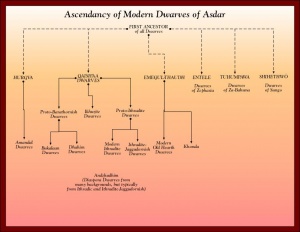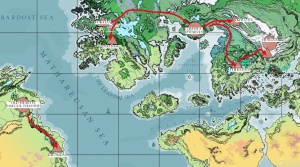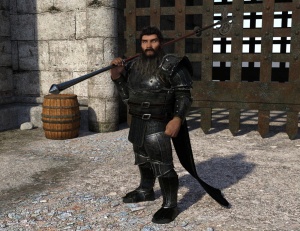Dwarves
The dwarves are likely the most friendly and commonly encountered humanlike with humans. Dwarves are mentioned in some of the most ancient human legends as servants of the gods and creatures of the mountains. Dwarves today retain much of their ancient customs, language, and resilience. They are leading innovators of titancraft technology and critical to the trade of the Pallathantic Region. The close proximity and commercial concourse with humans of the dwarves ensures that the relationship between and dwarves and humans will endure into the foreseeable future.
Dwarven Physiology
The shape of the dwarven body is broadly similar to humans, but significantly short and stockier. They range from 1.17m to 1.37m in height on average with very broad, heavy forms. Dwarves weigh 20 to 50kg more than humans. Dwarven men usually have thick beards. Dwarven women shave their beards regularly. Dwarven coloring and facial features vary nearly as much as those of humans among the various dwarven races. Dwarves are rather hardy and more resistant to bodily toxins. Dwarves like many humanlikes who dwell primarily under the earth, possess heat vision. Dwarves live much longer than humans. Their average lifespan is from 180 to 220 years, with significant variation among the dwarven races. Dwarves as a race are lactose-intolerant.
Dwarven Diet
Dwarves are omnivores, with a cultural preference for meat and liquors such as beer, ale, mead, and whiskey. Dwarves are fond of beef, lamb, and other heavy meat common to humans for which they will pay in hard currency. Dwarves are also resourceful enough to use the beasts of the deepearth as nourishment to prevent their dependence upon surface food. Subterranean dwarves are excellent preservers of food. Dwarven lands, however, are sufficiently abundant that they can provide much if not all of their demand for red meat.
History
Origins
Dwarven oral accounts reach back before the Flood of Aturyanda. Records written contemporary to the period from which the oldest dwarven writings survive date at least to the end of the Vorudian Cataclysms, (11,800 AS to 8,300 AS). Dwarven history is an important corroborative component to human historiography. Dwarves were thought to have been about 35 cm taller before the Flood, based upon legends and archeological evidence. In the old world, known antediluvian dwarven homelands are Midrardia (Qaish'aa), Bukalaa and Emegul-Thaudh, with additionally accepted homelands in Za-Bahuna, Sungo, and the new world. Amandal legends tell that there were three dwarven races before them in the Jaggudorns. Scholars are not able to verify this.
Migrations
Dwarven oral accounts, subsequently committed to stone, report the Vorudian Cataclysms, associated with the blue-violet illumination of the mysterious star, Vorud. During the Vorudian Cataclysms, dwarven groups which survived the Flood of Aturyanda tended to two differing strategies, remaining cloistered in their deepearth sanctuaries or trekking through or above the earth in search of new homes. Earth changes made both strategies potentially dangerous. During this time, migrating dwarven groups could not make or carry permanent records and so kept extensive oral accounts of their folk. Qaish'aa Dwarves reveal that their ancient homeland before the flood was in Midrardia. During the Vorudian Cataclysms, some groups left, most notably the forebears of the Bukalaan Dwarves and the forebears of the Ithradic dwarves. Tauhad is one of the oldest dwarven colony since the Vorudian Cataclysms in Pytharnia and the mother of all Qaish'aa dwarven colonies in the Jaggudorns. Dwarves of Old Hearth and of the Amandal Plateau largely remained in their mountain fastnesses. Dwarven scholars have determined that there is likely an antediluvian link between the Qaish'aa dwarves of Midrardia and the Khonda dwarves of Old Hearth (Emegul-Thaudh) based upon linguistic evidence and religious customs. Persistent legends of the dwarves reveal nine lost dwarven colonies which either remain hidden from human history or succumbed to the vicissitudes of the Vorudian Cataclysms.
Dwarves during the Yophenthean Empire
Dwarves view the period of Yophenthean Imperial rule with mixed thoughts, generally negative. Dwarves found the Arathracian nobles' religious justification for confiscating dwarven gold deeply offensive. In practice, Yophenthean rulers did not confiscate dwarven gold, but expressed religious dogma that all gold originated from the sun and was therefore subject to the stewardship of the offspring of Arathrax. Yophenthean rule however provided a lawful super-kingdom in which the dwarves could conduct commerce with humans with consistent laws, justice, and uniform currency.
Dwarves in the Medieval Period
In Medieval times, dwarven civilization experienced a rebirth in the metallurgical arts, early proto-titancraft, and politically. Dwarven magecraft also flourished, but some dwarven scholars believe this contributed to the practice of chaos magic among the dwarves that led to the collapse of some dwarven states.
Dwarves in modern times
Dwarves in modern times have formed lasting economic ties with humans by way of industry, commerce, and political commitment to the rule of law and order. The greatest divide among dwarves is between dwarves who live in their ancestral homelands and expatriot dwarves living in dozens of communities throughout the Pallathantic.
Expatriot Dwarves
Andzhuzádhim [fr. andz̧uzáḑim, Ithradic Dwarven Language] is a term which refers to a dwarf born and raised in a non-dwarven country. The term is usually simplified to Andzhu in non-dwarven languages. It is sometimes used as a term of derision by native born dwarves. Since the twenty fourth century, permanent dwarven communities have increased steeply in numbers in cities of the Pallathantic, especially the capital cities. The Andzhu dwarves in the Pallathantic are thought to number at least as much as 300,000. Many Andzhu are members of the Sovereign Archguild of Master Titancrafters of Pytharnia.
Dwarven Customs
social classes, family and marriage, birth customs, death and burial practices
Dwarven Burial Customs
Dwarven culture deems the earth to be the only suitable locale in which to inter their dead. The manner of preparing the body for burial has varied considerably through dwarven history and among the several dwarven sibling cultures. Additionally, the social status of the deceased can greatly determine the lavishness or paucity of the funereal accoutrements. Dwarven Kings have traditionally been embalmed and interred in great stone sarcophagi of fine workmanship. Dwarven commoners were buried in communal floor crypts, usually covered with stone tiles. To tread such tiles was considered a manner of connecting spiritually with the ancestors. Dwarves prefer by far to bury their dead in whole form, although exceptions include cremation and placement of the organs of the deceased in various vessels. But these rare exceptions almost usually insist that the remains be placed in the depths of the earth. Dwarves living abroad such as among human lands will have the dead of their number preserved and the corpse born by land route to their ancestral homeland to be interred in the depths. A land route is almost always taken as the thought of a calamity bringing about an accidental burial at sea is unthinkable.
Dwarven Languages
Dwarven Languages have been divided into broadly three groups, sometimes four. The most plentiful group comprises languages related to Ithradic, including the languages of the southwest Jaggudorns. The language of the Emegul-Thaudh (Old Hearth) is sometimes classified along with the Ithradic language. The Amandal Language comprises another group. Philologers are unable to establish any relationship between Amandal and Ithradic. The last group is the language of the dwarves of the new world.
Dwarven Races
There are several dwarven races throughout the world. They are not physiologically different from one another, except in superficial regards. In the west, there are four main dwarven races, the Bukalaan, the Qaish'aa, the Khonda (Old Hearth), and the Amandal. The Qaish'aa are the most wide-spread, being found in the Ithrads, and in the southeastern Jaggudorns. For this reason, Qaish'aa and Amandal dwarves are often found in the southern Jaggudorns, with the Amandals indigenous to the plateau and the Qaish'aa in mountainous periphery. The relationship between the Khonda and the Qaish'aa dwarves is a matter of ongoing scholarly discussion. In the East, the Shihethwö Dwarves of Kuham are one of the most ancient dwarven races in the world.
Amandal Dwarves
Many dwarven scholars consider Amandal Dwarves to hold the most ancient dwarven civilization in the world. The language of the Amandal Dwarves is not related to the Qaish'aa Language Family. Amandal dwarves also propitiate different divinities, but share many ancient rites of elemental worship with their Qaish'aa brothers. The Amandal Dwarves clain descent from an ancient antediluvian civilization of the Jaggudorns called Hurgva.
Midrardian Dwarves
Midrardia was once a great homeland of dwarves who dwelt in the caves of the mountains underneath the glaciers. When the glaciers melted some twenty to fifteen thousand years ago, most dwarves fled the cataclysms and migrated overland, some departing southwest for Barathorn and others southeast for the Jaggudorns and Pytharnia. The terms Midrardian Dwarves and Qaish'aa Dwarves are virtually interchangeable in regular use.
Qaish'aa
Most Qaish'aa dwarves are descended from the early dwarves of the Ithrads. The remaining dwarves are Bukalaan.
- Ancient North Jaggudornish, "Mountain Dwarves" not to be confused with Amandal Dwarves and Ithradite dwarves of the southwest Jaggudorns.
- Ithradic (Ithradic/Ithradite, Dagdorian, Sardichite, Gdelisican, Themetese)
This is a branch of dwarves that migrated about the same time as the ancestors of the Bukalaän Dwarves from Midrardia. They inhabited the mountains of midwest Barathorn.
Bukalaan
Khonda
The dwarves of Orhhymby are indigenous to Emegul-Thaudh. Some scholars believe they are more closely related to the Qaish'aa dwarves than to other dwarven races.
Shihethwö Dwarves
- in the Shwok Shanya Mountains in Kuham
Tuhumpawa Dwarves
Originating in Za-Bahuna
Entele Dwarves
Dwarves of Zephasia have dark skin and in keeping with their most ancient ancestors, prefer the mountainous regions. They are expert gem-cutters and often prefer gems to gold and other precious metals.
Deep Dwarves
There are dwarven legends of a race of their kind, enslaved by dragons, who dwell in the depths of the earth. These dwarves, called the Kvekki are thought to be cruel and imperialistic.
Dwarven States of the West
In the west, dwarven governments have a long standing of rule and tradition, interrupted only by the Middle Ages of Chaos.
Dwarven Kingship
Kinship in Dwarven Society
Dwarven Warfare
Ancient Dwarven Warfare Against Dragons
Modern Dwarven Warfare
Gods and Religion of the Dwarves
Seven Dwarven Immortals
Amandal Dwarven Religion
Dwarven Technology
Ancient Crafts
Metallurgy, Stone-cutting, Gem-cutting, Deepearth Engineering
Dwarvenfire
Dwarven Titancraft
Dwarven Worldview
The dwarven word equivalent for 'humanlike' means literally 'dwarflike' and the dwarven word for humans means literally 'little giants.' The expression 'mountain dwarf' does not mean a race of dwarves but means any dwarf who was raised in the mountain fastnesses of the dwarven folk. Dwarves are friendly to humans, but regard their own kind with great admiration and believe certain customs, lore, and practices should abide with exclusivity to the dwarves. Dwarves regard the earth, particularly the earth beneath the mountains, as the sacred womb of creation.
See Also
| This article is a stub. It requires further development by the creator. |


